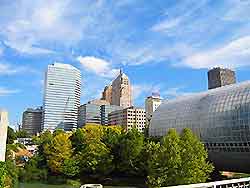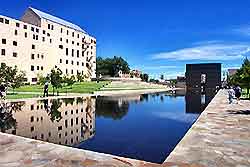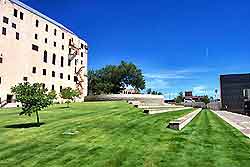Oklahoma City Tourist Information and Tourism
(Oklahoma City, Oklahoma - OK, USA)

Oklahoma City, the largest city in the state of Oklahoma (OK), became the capital in 1910. The city was founded in 1889, when many thousands of people raced to unclaimed plots of land, and since then Oklahoma City has thrived, with much wealth being gained after oil was discovered in 1928. Sadly though, Oklahoma City is perhaps most famous for the tragic bombing of the Alfred P. Murrah Federal Building, which took place in April 1995, when 168 people lost their lives.
These days, Oklahoma City has regained its status and self-confidence, with many must-see attractions, such as the National Cowboy and Western Heritage Museum. The city is also well-known for its enormous Red Earth event, the world's largest Native American festival.
There are plenty of affordable hotels throughout Oklahoma City, many of which can be found in the city center, along North Lincoln Boulevard, Waterford Boulevard, North Broadway and nearby highways. Representing all levels of accommodation, hotel rooms in Oklahoma City should always be reserved in advance. A number of hotels are also conveniently close to Will Rogers World Airport (OKC), which stands just 5 miles / 8 km from central Oklahoma City. More information about
Oklahoma City Hotels.
Tourism is now a major part of life in Oklahoma City and the main tourism office is the Oklahoma City Tourist Information Center, which can be found at 123 Park Avenue. Full of invaluable tourism information about sightseeing and guided tours around Oklahoma City, the center boasts a range of travel guides about individual tourist attractions and tourism in many of Oklahoma City's neighborhoods, including the Asia District, the Bricktown / Downtown area, Capitol Hill Main Street, the Paseo Arts District and Stockyards City.

Oklahoma City contains numerous popular tourist attractions, such as the Civic Center Music Hall - offering a range of performances, including ballet, opera, theatrical events and major concerts; Oklahoma City Zoo - containing around 2,200 animals and regarded as one of America's finest zoos; Bricktown Ballpark - with regular games by the Oklahoma City team, the Redhawks, with a maximum capacity of around 12,000 people; the Remington Park Race Track - a world-class track with fast-paced and exciting horse races; and Lake Draper - a large and scenic lake, with a range of water sports and recreational activities.
Other notable tourist attractions in Oklahoma City include the Oklahoma City National Memorial - remembering the victims and survivors of the 1995 Oklahoma City bombing; Oklahoma City University - one of the city's striking landmarks, listed on the National Register of Historic Places; Oklahoma State Capitol - an imposing neo-Classical building built in the early 20th century; Myriad Botanical Gardens and Conservatory - a unique landmark close to downtown's modern skyscrapers and high-rises; and the Will Rogers Horticultural Gardens - containing the Garden Exhibition Center, the Ed Lycan Conservatory and a large arboretum. More information about
Oklahoma City Tourist Attractions and
Oklahoma City Landmarks.

Some of the main museums and art galleries in Oklahoma City include the 45th Infantry Division Museum - full of history and information about Oklahoma's military past; the National Cowboy and Western Heritage Museum - with information about the American West and classic cowboy-related memorabilia; Oklahoma Firefighters Museum - showing how firefighting equipment has evolved over the last century; the Omniplex - also known as the Air and Space Museum, boasting a host of interactive exhibits; the State Museum of History - celebrating the city's diverse and colorful history; and the Oklahoma City Art Museum - focusing on modern art, with works by both American and international artists. More information about
Oklahoma City Museums and
Oklahoma City Art Galleries.
Tourist attractions close to Oklahoma City include the Guthrie - former capital of Oklahoma State until 1911, located to the north of Oklahoma City; the Route 66 Museum - celebrating this world-famous route, with interesting information about the history of the highway; the Blue Whale - a major roadside attractions, situated on the historic Route 66 highway; the Wichita Mountains Wildlife Refuge - a simply vast, protected nature reserve, full of native flora and fauna; and Tulsa - known as a major cultural center, within driving distance of Oklahoma City. More information about
Oklahoma City Attractions Nearby.
More Oklahoma City Information / Fast Facts and Orientation
- Country: United States of America (USA)
- Location: Oklahoma City County, Oklahoma (OK)
- Status: state capital and county seat
- Area: approximately 607 square miles / 1,572 square kilometers
- Population: approximately 525,000
- Language: American English
- Currency: US Dollar (USD)
- Time zone: GMT - 6 hours Central Standard Time (daylight saving time is observed)
- Country dialing code: +1
- Telephone area code: 405
- Religion: various religions
- Average daily January temperature: 8°C / 46°F
- Average daily July temperature: 34°C / 93°F
 Oklahoma City, the largest city in the state of Oklahoma (OK), became the capital in 1910. The city was founded in 1889, when many thousands of people raced to unclaimed plots of land, and since then Oklahoma City has thrived, with much wealth being gained after oil was discovered in 1928. Sadly though, Oklahoma City is perhaps most famous for the tragic bombing of the Alfred P. Murrah Federal Building, which took place in April 1995, when 168 people lost their lives.
Oklahoma City, the largest city in the state of Oklahoma (OK), became the capital in 1910. The city was founded in 1889, when many thousands of people raced to unclaimed plots of land, and since then Oklahoma City has thrived, with much wealth being gained after oil was discovered in 1928. Sadly though, Oklahoma City is perhaps most famous for the tragic bombing of the Alfred P. Murrah Federal Building, which took place in April 1995, when 168 people lost their lives. Oklahoma City contains numerous popular tourist attractions, such as the Civic Center Music Hall - offering a range of performances, including ballet, opera, theatrical events and major concerts; Oklahoma City Zoo - containing around 2,200 animals and regarded as one of America's finest zoos; Bricktown Ballpark - with regular games by the Oklahoma City team, the Redhawks, with a maximum capacity of around 12,000 people; the Remington Park Race Track - a world-class track with fast-paced and exciting horse races; and Lake Draper - a large and scenic lake, with a range of water sports and recreational activities.
Oklahoma City contains numerous popular tourist attractions, such as the Civic Center Music Hall - offering a range of performances, including ballet, opera, theatrical events and major concerts; Oklahoma City Zoo - containing around 2,200 animals and regarded as one of America's finest zoos; Bricktown Ballpark - with regular games by the Oklahoma City team, the Redhawks, with a maximum capacity of around 12,000 people; the Remington Park Race Track - a world-class track with fast-paced and exciting horse races; and Lake Draper - a large and scenic lake, with a range of water sports and recreational activities. Some of the main museums and art galleries in Oklahoma City include the 45th Infantry Division Museum - full of history and information about Oklahoma's military past; the National Cowboy and Western Heritage Museum - with information about the American West and classic cowboy-related memorabilia; Oklahoma Firefighters Museum - showing how firefighting equipment has evolved over the last century; the Omniplex - also known as the Air and Space Museum, boasting a host of interactive exhibits; the State Museum of History - celebrating the city's diverse and colorful history; and the Oklahoma City Art Museum - focusing on modern art, with works by both American and international artists. More information about Oklahoma City Museums and Oklahoma City Art Galleries.
Some of the main museums and art galleries in Oklahoma City include the 45th Infantry Division Museum - full of history and information about Oklahoma's military past; the National Cowboy and Western Heritage Museum - with information about the American West and classic cowboy-related memorabilia; Oklahoma Firefighters Museum - showing how firefighting equipment has evolved over the last century; the Omniplex - also known as the Air and Space Museum, boasting a host of interactive exhibits; the State Museum of History - celebrating the city's diverse and colorful history; and the Oklahoma City Art Museum - focusing on modern art, with works by both American and international artists. More information about Oklahoma City Museums and Oklahoma City Art Galleries.